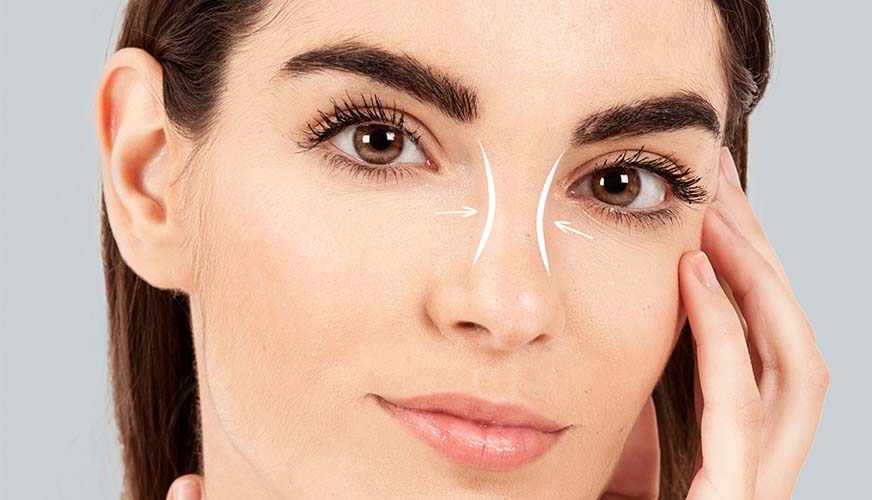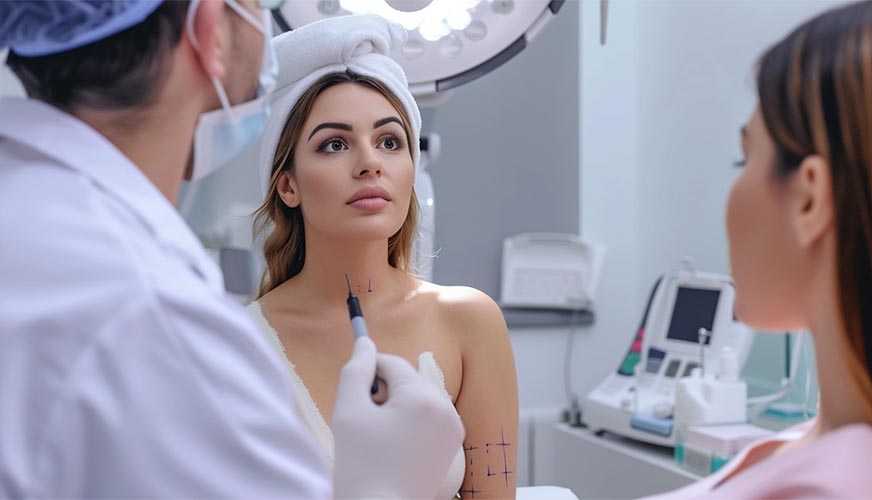22 August 2024
Nasal septum curvature surgery
- 1626
- 14 August 2024
What is Open Rhinoplasty and how should it be done?
Each person's nose is unique, so rhinoplasty should be planned and performed individually. The goal of aesthetic nose surgery is to change the appearance of the nose in harmony with other features of the face. During rhinoplasty, the nose can be shortened or lengthened, reduced or enlarged, its shape can be changed, the nostrils can be reduced, the nose hump can be lost, the tip of the nose can be lifted and thinned. How much and how much of what we listed will be done is clarified only after the assessment of the anatomical features of the nose and the skin of the nose during the consultation.
Inside the nose is a septum made of bone and cartilage. When the curvatures in this septum are at a level that blocks the airway, it causes difficulty breathing. Bad breath is caused by soft tissues other than bone and cartilage. So, problems in bone, cartilage and soft tissue can be eliminated at the same time with aesthetic nose surgery.
Your first meeting with us is really important. At our first meeting, we want you to tell us all the details that bother you about your nose. However, in this case, we can evaluate your wishes related to this operation and tell you whether these wishes will be possible with surgical intervention.
As in all aesthetic surgeries, our main philosophy in nose surgery is that surgical results that do not lose naturalness and do not give the appearance of a surgical nose, which is not understood by many people, are the most beautiful results.
Details of aesthetic nose surgery
A picture is taken before the nose operation. It is imperative that you undergo all necessary due diligence on your transaction. At the same time, if you have additional medical problems, you must inform your doctor about this. Nasal operations are usually performed under general anesthesia. But local anesthetic can be used during small interventions at the tip of the nose. The operation takes an average of 1.5 hours. The incisions can be made inside or outside the nose. Cuts heal without scars as they are esthetically stitched. At the end of the operation, you will have a cast on your nose, but no tampon. Our nose operations are performed without tampons. It is recommended to leave the cast on for 1 week. If the nose operation is included in the painless operation group, you will be prescribed 1 painkiller and 1 antibiotic tablet after the operation, just in case. After the operation, you will have difficulty breathing through your nose for the first weeks due to the swelling inside, but some drops and creams that we will prescribe for this period will reduce your complaint. If your operation was performed in the morning, in the evening, if it was performed in the afternoon, you will be allowed to go home the next day. There will be swelling and bruising around the eyes for 2-5 days. This color change and swelling usually disappear within 1 week, the day we remove the cast. But during this 1 week, putting an ice compress on the swollen areas will relieve you.
With 1, the nose will take the final state of its shape and get a natural look. Nose surgery can be performed in any season. Do not wear glasses, do not go to the sea, do not do heavy sports within 1 month after the operation. It was necessary to stay away from all traumas to the nose within 1 month. After the operation, you will come for check-ups in 1, 3, 6 months, and your current nose will be compared with the previous nose picture.
Note: All surgical operations may have complications and risks. As with any operation, there may be anesthesiological risk in nose surgery, as well as bleeding, infection, and wound healing problems. At first, there will be numbness, but it is temporary. If you do not encounter these risks and complications listed in many of the operations we perform, you should definitely talk to your surgeon about it. As with all aesthetic interventions, there may be minor revisions after rhinoplasty.
Open Rhinoplasty. Speed of improvement. Ease of surgery
With the open method, more of the tip of the nose becomes numb. A half-millimeter thick nerve is cut in the middle of the nose. In the opening method, nasal edema lasts longer than in closed rhinoplasty. A small artery and vein are cut in the middle of the nose. Stopping these structures does not disrupt the circulation, but prolongs the treatment period. Closed nose aesthetics improves faster. Open rhinoplasty is easier to perform. Therefore, open rhinoplasty is preferred for education. Closed rhinoplasty is a more difficult method.
In order to get a more natural, beautiful and functional result in nose aesthetics, the technique to be used should be determined before the surgery with personal planning. Choosing the appropriate technique for the purpose of the operation is indispensable for success. Advantages of Open Rhinoplasty:
These days, nose surgery among doctors is even closed rhinoplasty?open rhinoplasty? If there is no agreement, it is very natural for you to make a mistake. If you, as a doctor, choose a surgical case, that is, if you say, "I don't take risks by doing a difficult nose, I will only do easy noses," you can perform your operations very well until the end of your life with a surgically connected technique. However, if half of your patients are revision rhinoplasty (correction) patients, a significant number of them are crooked due to injury, the nose bridge is collapsed, the tip of the nose is dropped, you will inevitably use open rhinoplasty sooner, and after a while you will start to get incredible results in all cases of open rhinoplasty in your hands. .What is my personal opinion as a nose surgeon who has performed thousands of nose surgeries? The standard nasal structure of our people is very problematic. I am one of those who think that the open rhinoplasty approach to nasal aesthetics can be obtained in a country where there are many different and difficult cases, from nose tip to nasal wing problems, axis curvature to completely collapsed nose as a result of injury. Over the years, your surgical adventure changes, and thanks to the experience you gain, updating yourself, you decide more easily which technique is preferable for which patient. If I were a rhinoplasty surgeon working in Northern European countries, I think that I would have performed more surgeries with related techniques. In countries such as Sweden and Norway, where even an ordinary nose can be accepted as beautiful according to our country, a closed technician is already enough for small changes. Of course, we have patients who work with closed rhinoplasty and have very good results. But as I said, what is important here is to do special technical work on the structure of a person's nose. It is a big mistake to prefer only one technique and to be immersed in the idea that I should not do scarless nose aesthetics, so it is also a big mistake to say that I will choose only the related technique. The technique determines whether you should lift fully or partially. Closed rhinoplasty was described about 100 years ago, but since it was sometimes insufficient to solve the functional and aesthetic problems of the nose, open rhinoplasty was prescribed 25-30 years ago. In other words, open rhinoplasty is a more modern approach. When we need to get closer to the cartilaginous bone structure, the bridge of the nose and the wings of the nose, which ensures the nose is straight and even, the open technique we choose provides us with a perfect surgical meeting area. Open technique is easier to solve not only aesthetic but also functional problems (nasal congestion). With the closed technique, you have less chance of experiencing problems such as falling of the tip of the nose and stuffy nose in the open technique. Contrary to what people think, in the closed technique, people think that the surgery is done with a very small incision, but the situation is not like that at all. As a result of successful open rhinoplasty operations and the insufficient closed technique, the need to develop closed rhinoplasty has emerged, so the delivery technique with closed technique is used to remove all the structures of the tip of the nose and the wings of the nose from the inside of the nose and reinsert them into the nose after surgery. In other words, a kind of semi-open rhinoplasty approach is used, but I do not believe that it perfectly controls the nasal bridge and the valve region, especially in difficult and revision nose aesthetic cases accompanied by functional problems. My patients who have undergone open rhinoplasty have more pain or scars at the site of the incision to this day. I have never seen such a situation.
About Open Rhinoplasty:
Nose aesthetics is the first among the aesthetic operations performed in our country. In addition, it is also possible for us to become a world leader in this matter. Rhinoplasty is another name for today's nose surgery. The operation is mainly to shape the bone and cartilage structure of the nasal skeleton. Although not off the agenda, there is no consensus on rhinoplasty surgery and many unknown and conflicting rumors persist. So, we can't find out what is right and what is right. We went to the Doctor who knows both methods. Aesthetic clear OP. We went to Dr. Farid Aliyev and asked F. Aliyev our questions.
And F. Aliyev answers our questions.
There are two methods of nose surgery, open and closed. Which of these methods gives better results? Rhinoplasty can be performed in two ways, open and closed. Open rhinoplasty involves an incision in the skin between the two nostrils, which we call the columella. In closed rhinoplasty, all incisions are made through the nose.There are no visible skin incisions. For open rhinoplasty, they claim to have more control over the nose. However, even if everything is done immediately in the open technique, because the integrity of the skin covering the nasal skeleton is broken, the adequate assessment of the connection between the nose bridge and the tip during the operation is especially weak. This is actually a vital disadvantage. The scar is out. Can we say that closed rhinoplasty will give better results in this case? The debate continues, which technique gives better results. However, these debates continue in a wrong way because there is no advantage between the two methods. Choosing here is more related to the experience of the surgeon. Closed rhinoplasty does not leave visible scars, but requires a high level of experience and technical equipment; All surgical maneuvers that can be performed with open rhinoplasty can be performed with closed hands in experienced hands. Is it difficult to breathe after rhinoplasty surgery? Shortness of breath that develops after rhinoplasty is a well-known problem that is often neglected but should be emphasized. In the early postoperative period, shortness of breath due to swelling is natural and temporary, but in the long term, if it persists even after the swelling has subsided, there is a problem. Rhinoplasty, by its nature, is an operation that narrows the airways. Therefore, a hidden, mild septal deviation, which does not cause shortness of breath before the operation, can cause shortness of breath in the patient after the operation if it is not noticed and corrected by the surgeon. For this reason, whether or not all patients have breathing difficulties, septum deviation or concha hypertrophy, which may cause breathing difficulties, should be carefully evaluated during the operation and necessary measures should be taken. If these conditions are met, breathing problems are not encountered after rhinoplasty surgery.




